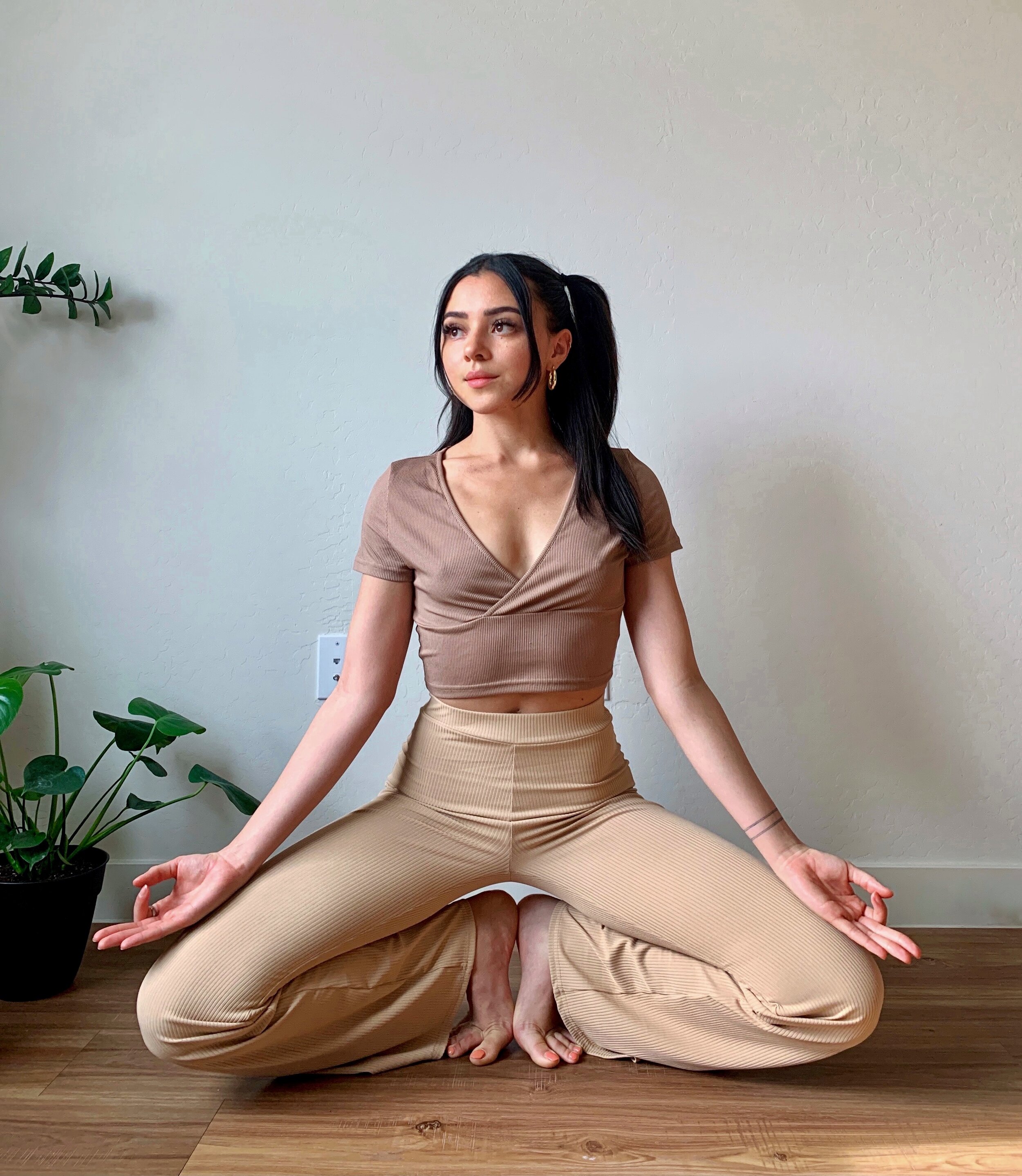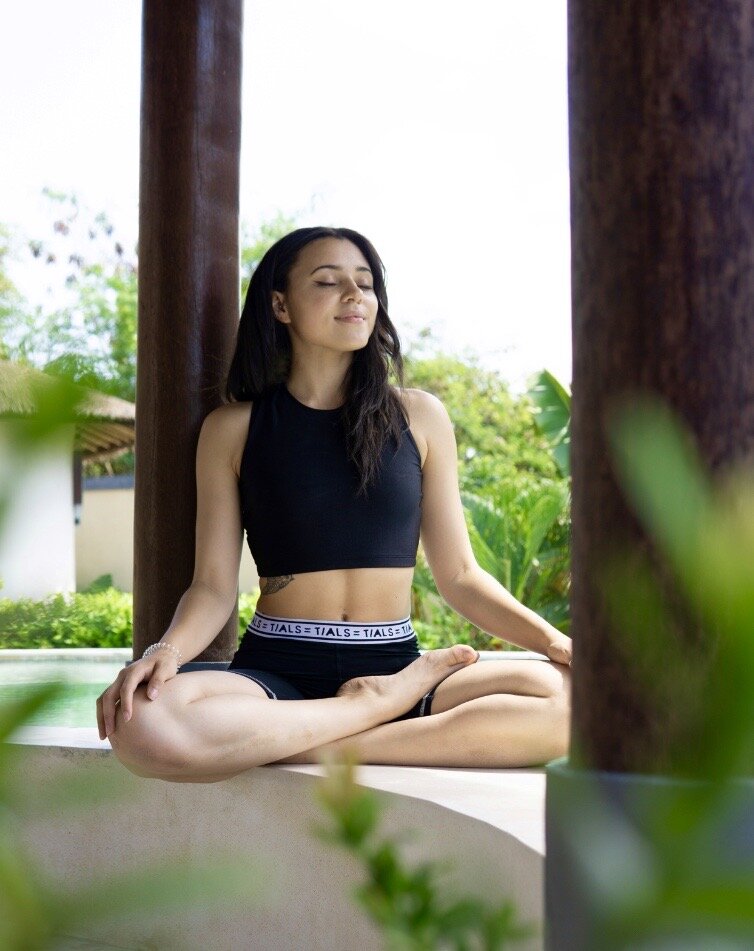Just like our bodies, our minds need training in order to function at their best. Mindfulness is a form of mental training that supports the mind to be more focused, effective and present to our experiences. It’s often described as the practice of bringing your full attention, in an open, non-judgmental way to the present moment.
I like to think mindfulness also involves acceptance. Meaning that we pay attention to our thoughts and feelings without judging them — without believing, for instance, that there’s a “right” or “wrong” way to think or feel in a given moment. When we practice mindfulness, our thoughts tune into what we’re sensing in the present moment rather than getting stuck in loops about the future or the past, thus, increasing stress, which over time can take a toll on our mental + physical wellbeing.
You can develop mindfulness muscles by practicing to bring your attention to the present moment in everyday activities. Here are 4 simple ways you can bring mindfulness into your daily life:
BE MINDFUL WHEN EATING — Mindful eating is a way to improve your relationship to food, and even help change unwanted eating patterns or behaviors. It’s about allowing yourself to become aware of the positive + nurturing opportunities that are available through food selection and preparation by respecting your inner wisdom.
A few ways we can practice eating mindfully:
Before eating say a prayer, set an intention or simply give gratitude to the food in front of you. Think about who, how and what it took to get that food on your plate. Give thanks to farmers, grocery workers, animals, etc. and for the nutrients, energy and life that the food is about to provide for you.
Slow down the pace at which you eat. For example, take breaks during bites, chew more slowly, take a break to breathe and rate your fullness. In Ayurveda (yoga’s sister science) a golden eating rule is to chew each bite of food 32 times. Ayurveda says that how you eat is even more important than what you eat.
Eat away from distractions, such as the phone, TV, computer or even eating in the car.
Take note on how your body lets you know when it’s hungry and full so you can recognize these cues more easily. And then you can use these cues to guide your decision on when to begin and end eating.
Notice your responses to food (likes, dislikes, neutral) without judgement.
Choose to eat food that is both pleasing and nourishing by using all of your senses (smell, taste, sight, sound) while eating.
Become aware of and reflect on the effects caused by unmindful eating (for example, eating out of boredom or sadness, overeating to the point of feeling uncomfortable).
USE SOCIAL MEDIA CONSCIOUSLY — Social media can be a time wasting hazard as we mindlessly scroll through the feed and lose touch with the present moment. Be mindful on social media by bringing a conscious intention to the amount of time you will spend on it before starting. While using social media, notice the impact it has on your emotional state — does it make you feel good, bad, bored, interested? By tuning in to the impact of activities mindfully we can start to make more conscious decisions which support our wellbeing.
A few more ways we can practice mindfulness online:
Take time to clean your feed. Unfollow people that regularly complain or post negative content, and consciously choose to follow more positive people and pages. This will make a world of difference if you end up scrolling through unconsciously, because you will unconsciously be taking in uplifting information. You get to choose who you follow. Make sure you choose well.
When posting, let go of your attachment to the outcome; don’t expect a certain number of likes. Unconsciously, you might think that likes = validation and that the more likes you get the more liked you are as a person, or that if you don’t get likes that you’re not liked as a person. The amount of likes you get has nothing to do with who you are, and has nothing to do with your worth. Some people actually pay for likes! It truly means nothing. Focus on posting things that you already like, versus posting things that you feel need validation or recognition.
BE PRESENT IN CONVERSATIONS — Using mindfulness while communicating with others simply means taking the time to be truly present. During a conversation this might look like paying attention to the body language of a speaker, being open to their emotions, maintaining consistent eye contact, really sharing the moment with them, besides actively listening to their words. In order to achieve this, we need to learn to put ourselves aside for a bit, and give space to the other person during the exchange.
More points to consider:
Attempt to truly understand what the other person is saying without judgement, criticism or defensiveness.
In the event that you’re involved in a conversation in which the other person says something that offends you, pause. When you react without thinking, you’re jumping to conclusions. When you’re jumping to conclusions, you’re not really listening to what the other person is saying. When you aren’t listening to what is being said, you aren’t having a mindful conversation. When someone makes a statement you would normally be inclined to react, do this: Listen. Take a breath. Then respond.
Make your conversion other-focused. During many conversations, rather than listening to what the other person is saying, we can become more concerned with what we’re going to say next. When your communication becomes other focused, you really are trying to understand what the person is communicating. This is the true definition of listening. Listening helps create mindful conversation. Listening leads to the deepest sort of connection that we all seek.
This mindfulness exercise may seem challenging at first, but with practice one can soon discover its importance in order to build real relationships based on genuine listening, trust and openness.
JOURNAL & MEDITATE — Both writing and meditation are great tools you can use to help live more mindfully. Meditation sharpens our attention and expands our awareness by allowing us to pause from the busyness of our lives in order to delve deeply into the roots of our experiences. Journaling provides a complementary practice — when we put thoughts to paper (or type them) we’re able to clear our mind and gain perspective on any given situation. Journaling is a chance to document our process, to reflect upon and release our longings and questions.
Incorporating these practices into your life doesn’t need be time-consuming or elaborate. In fact, setting aside 20 minutes each day could be all you need to reap the benefits. Below is an effective exercise that integrates meditation + journaling — plus a bit of movement to start things off:
Move (5 minutes). Stir up some energy: Do yoga poses, stretch, jump around, shake, make some noise — anything that lets you get in touch with your body to create a physical + emotional space conducive to meditation and journaling.
Meditate (5 minutes). Once the energy is stirred, sit in a comfortable position, spine tall, eyes closed or gaze soft. Focus on the breath as you allow the energy gathered to settle and ground. Open up to your senses and welcome in all sensations.
Journal (5 minutes). Express yourself from a place of spaciousness, allowing your journaling to be organic and intuitive. It could be freestyle — writing down with no direction or filter — or using a journal prompt. Write until you feel complete enough in the moment.
Meditate (5 minutes). After you’ve completed journaling, pause, and then return to meditation. Observe the thoughts and feelings that arise from the journaling. Allow them to wash over you without judgment or attachment.















